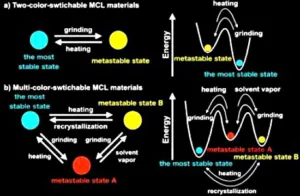A team of researchers headed by Professor Youhei Takeda of the Department of Applied Chemistry within the Graduate School of Engineering at Osaka University (Osaka, Japan) have created multi-color MechanoChromic Luminescent (MCL) materials that exhibit efficient Thermally Activated Delayed Fluorescence (TADF) emission.
TADF emitters represents a class of materials that offer the potential to provide not only efficient but also long lifetime OLED devices. In addition, since most OLEDs devices with high energy conversion efficiencies depend on expensive precious metals, TADF light emitting devices can achieve equal or better efficiency at much lower cost.
A recent article by the team on this subject is entitled “Thermally activated delayed fluorescent phenothiazine–dibenzo[a,j]phenazine–phenothiazine triads exhibiting tricolor-changing mechanochromic luminescence.” The article was published in Chem. Sci., 2017. A copy of this article is available on-line and can be found here.
This article provides a great deal of detailed information on the materials and the color generation mechanisms. In their article, the researchers report the nature of their development in the following technical terms. “Donor-acceptor-donor (D-A-D) p-conjugated multi-functional molecules comprising dibenzo[a,j]phenazine (DBPHZ) as an acceptor and phenothiazines (PTZ) as donors have been developed. Most importantly, the D-A-D compounds exhibit not only distinct tricolor-changeable MCL properties but also efficient TADF.”
A somewhat less technical, top level description of these materials and mechanisms is as follows.
MCL materials change their color in response to a change in their environment including a change in pressure or temperature. Most MCL materials can only change between two colors. This limits their range of potential applications. The new materials, however, can switch between three colors: yellow, red and orange. The color shift occurs in response to heating, fuming and grinding.
Most MCL materials generate two colors by switching between a stable state and one metastable state. To realize multi-color MCLs, more metastable states are necessary. To create these states, the researchers designed new molecules utilizing a “conformationally-switchable” phenothiazine (PTZ) as the donor. PTZ can assume two distinct conforms or structures. As a result, it becomes possible, in principle, to create a total of four metastable states. The nature of the transitions and the metastable states are illustrated in the figure below.
In explaining the observed emission phenomena, the team reported that “the three colors derive from different conformers in which each PTZ takes either an equatorial or axial conformation relative to the DBPHZ core.”
The researchers report prototyping OLED devices using the newly developed materials. The efficiency of these OLEDs was found to be three times higher than the theoretical maximum when conventional fluorescent materials are used. More specifically, the prototype OLED devices achieved an external quantum efficiency up to 16.8%, which significantly exceeds the theoretical maximum of ∼5% of conventional fluorescent emitters.
It is not clear what advantages the new materials may have compared to other TADF emitters and whether the new materials are sufficiently stable for use in commercial OLEDs. None-the-less, Takeda expressed the hope that “Our molecule could become a basis for efficient light-emitting devices and pressure- and temperature-responsive sensors in the future.” -Arthur Berman
Osaka University, Youhei Takeda, [email protected]

